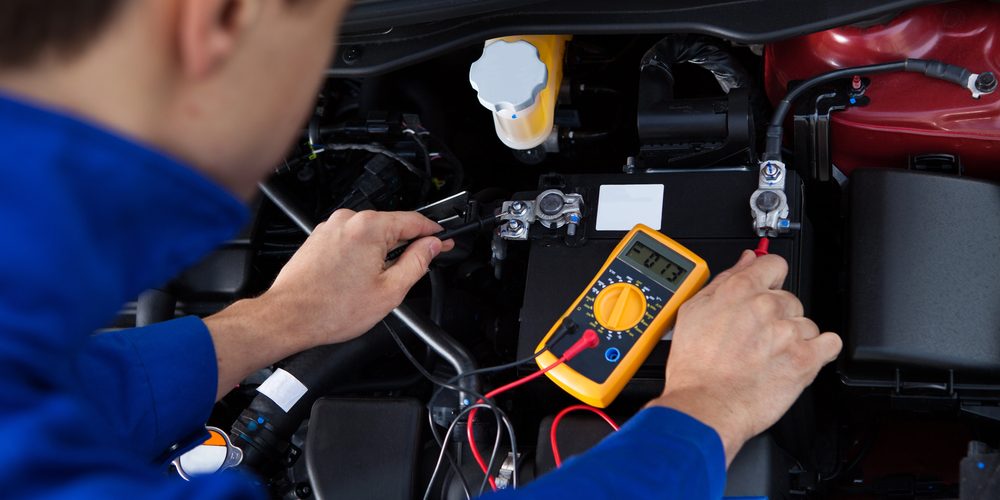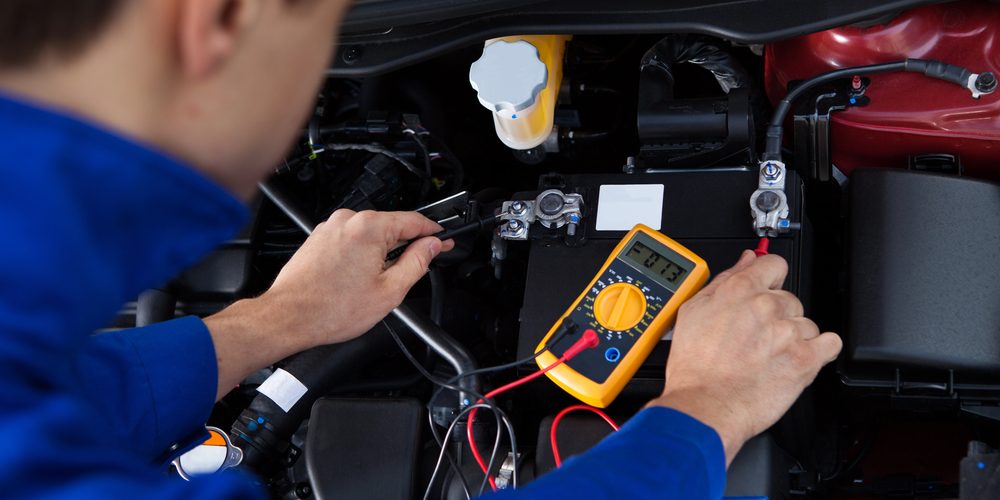Why Car Batteries Fail Without Warning


Car batteries often appear to fail without warning because the early stages of deterioration do not produce symptoms that drivers can detect. A battery can hold a normal resting voltage even when its internal structure is breaking down. This creates the impression of sudden failure, when in reality the process has been progressing quietly for months.
The issue lies in how modern lead acid batteries age. Their internal resistance rises long before voltage drops, which means a battery can display a healthy reading on a multimeter while offering far less usable power under load. As the plates inside the battery shed material, or as sulfate crystals form on their surfaces, the battery becomes less capable of delivering the high current needed for starting. These changes do not affect static voltage, so drivers do not see any visible sign of the decline until the cranking demand exceeds the battery’s remaining capacity.
Modern vehicles mask the problem further. Electronic charging systems maintain voltage stability even when the battery struggles to hold a charge. Engine control modules, alternator management and voltage smoothing circuits keep the system operating within a narrow range, which hides the strain the battery is under. The vehicle may start normally one day and fail the next because the underlying weakness only becomes visible when temperatures drop or when the starter motor demands more current than the weakened plates can release.
This combination of rising internal resistance, hidden chemical deterioration and voltage smoothing by the vehicle’s electronics creates the familiar experience of a battery that appears to die overnight. In most cases the failure has been developing for an extended period, with no clear signs until the moment the battery can no longer support the load required to start the engine.
How Lead Acid Batteries Deteriorate Internally
Lead acid batteries fail through a series of internal chemical and structural changes that progress long before voltage begins to fall. These changes reduce the battery’s ability to deliver current under load, which is why a failing unit can appear healthy on a simple voltage check while no longer providing reliable starting power.
Sulfation is one of the earliest forms of deterioration. During normal discharge, lead sulfate forms on the surface of the plates. If the battery remains partially charged for extended periods, these sulfate crystals harden and become difficult to reverse during charging. As the crystals expand, they reduce the active surface area of the plates and restrict the flow of ions through the electrolyte. This raises internal resistance, which slows charging, weakens cranking performance and increases heat during high load events.
Plate shedding is another major cause of early failure. The active material on the lead plates gradually breaks away as the battery cycles through repeated discharge and recharge phases. The shed material settles at the bottom of the battery case, where it can accumulate to the point that it contacts or bridges internal components. This condition reduces capacity and can lead to internal short circuits, which cause rapid voltage collapse during starting.
Electrolyte stratification affects many modern batteries that spend most of their life in partial charge states. When a battery is not regularly brought to full charge, the electrolyte separates into layers. Denser acid collects at the bottom of the case while the upper layers become diluted. The lower portion of the plates remains submerged in stronger acid, which accelerates corrosion and increases wear. The upper portion receives weaker electrolyte contact, which limits chemical reaction and reduces overall output.
As these processes progress, internal resistance rises and available cranking current falls. Voltage measurements taken at rest still appear normal because voltage reflects charge level, not structural condition. The battery only shows signs of weakness when asked to deliver high current, at which point the internal resistance causes a sudden voltage drop that prevents the starter motor from turning the engine.
These hidden chemical and mechanical changes explain why many batteries continue to show acceptable voltage readings until the moment they fail under load.
Why Short Trips and Stop Start Systems Accelerate Car Battery Failure
Short trips and stop start systems place demands on a car battery that shorten its lifespan by keeping it in a constant cycle of high output and limited recharge. Modern vehicles rely heavily on electrical power during every drive, and the battery often does not receive enough sustained charging time to recover from each start sequence. This pattern creates the same stresses seen in electric vehicle load cycles, but in a system designed around traditional lead acid chemistry.
Every engine start requires a surge of current that places significant strain on the plates inside the battery. In older vehicles, this load was followed by long periods of uninterrupted alternator charging, which restored the battery to full capacity. Short urban trips break this pattern. The engine may run for only a few minutes at a time, and the alternator cannot deliver a complete recharge before the vehicle is switched off again. The battery remains in a partial state of charge, which increases sulfation and raises internal resistance.
Stop start systems add even more demand. These systems shut the engine down at traffic lights or during brief stops, then restart it as soon as the driver releases the brake. Each restart requires another high current draw, which accelerates the wear on the plates. The battery experiences repeated discharge cycles without the long recharge periods needed to stabilise electrolyte chemistry and clear early sulfate deposits.
Modern cars also carry more electrical load during each short trip. Power steering pumps, air conditioning compressors, heated glass elements, sensors and communication modules all draw current at idle. When the alternator output is reduced at low engine speeds to improve efficiency, the battery must supply more of this power. This increases the depth of each discharge and leaves less opportunity for full recovery during the drive.
The combined effect of frequent high current demands, limited recharge time and continuous accessory load creates a deterioration pattern that moves quickly. The battery remains undercharged, sulfation develops, internal resistance rises and the available cranking current falls long before voltage readings begin to show decline. Short trips and stop start systems therefore accelerate battery failure by placing the battery in a near constant state of chemical and electrical stress.
How Parasitic Draw Masks Early Warning Signs
Parasitic draw is a constant drain on the battery that continues long after the vehicle is switched off. Modern cars contain multiple electronic control units that remain active to manage security, communication networks, keyless entry systems and data storage. These modules operate in low power states, but they do not shut down entirely. Their combined draw removes charge from the battery slowly and unpredictably. This reduction happens quietly in the background, which hides the early stages of battery deterioration.
Infotainment systems and connected services add further load. Touchscreens, telematics units, navigation hardware and wireless communication modules need regular access to power so they can update data, maintain network status or prepare for quick startup. Even when the ignition is off, these systems can wake periodically. Each wake cycle increases current draw and reduces the battery’s reserve capacity without producing symptoms the driver can see.
Alarm systems and keyless entry hardware also contribute to parasitic loss. These components monitor interior and exterior sensors, check for key signals and maintain communication with the vehicle’s security modules. Their activity is continuous, and in some cases the draw increases when environmental conditions cause sensors to trigger more frequently. This behaviour causes additional discharge during long periods of parking or infrequent use.
As the battery ages, internal resistance rises. The parasitic load removes charge at the same rate it always has, but the weakened battery cannot recover as effectively during the next drive. The voltage remains stable enough to appear healthy, yet the available current drops to a point where starting becomes unreliable. Drivers often experience sudden failure because the battery seemed normal until the moment the internal resistance combined with the overnight drain was enough to prevent the engine from turning over.
Parasitic draw therefore masks early warning signs by lowering charge levels in a gradual, hidden way. The vehicle starts normally for weeks or months until the battery reaches a threshold where the next cold start or accessory load exposes the loss of capacity.
The Hidden Impact of Heat on Battery Chemistry
High ambient temperatures are one of the most damaging influences on a lead acid battery because heat accelerates the chemical reactions inside the cells. As temperature rises, the electrolyte evaporates more quickly, which reduces the volume of fluid available to support ion movement between the plates. Even small losses in electrolyte height expose portions of the plates to air, and this exposure leads to rapid oxidation and a permanent drop in capacity.
Heat also increases the rate of grid corrosion. The metal framework that supports the active material on each plate slowly breaks down as the battery cycles. Elevated temperatures speed this process by accelerating chemical reactions between the grid alloy and the electrolyte. Once the grid structure weakens, the active material loses support, which leads to plate shedding and higher internal resistance. These changes occur quietly and often long before the driver experiences any starting issues.
Electrolyte stratification becomes more severe in hot environments. When the electrolyte warms unevenly, the heavier acid sinks while the lighter mixture rises. This separation results in the lower part of the plates sitting in stronger acid, which increases corrosion, while the upper portion becomes starved of reactive material. The battery then operates at reduced efficiency because only part of each plate is engaged in the chemical reaction during charging and discharging.
High temperatures also increase the battery’s self discharge rate. A fully charged battery loses energy faster in hot conditions because chemical reactions continue at an elevated pace even when the vehicle is not in use. This means a battery can drop from a stable charge level to a weakened state more quickly during periods of parking or storage, especially if the car experiences additional parasitic draw from modern electronics.
These combined effects make heat one of the strongest factors in early battery failure. The chemical deterioration progresses quietly inside the case and remains hidden behind stable voltage readings until the available cranking capacity falls below what the starter motor requires.
Why Cold Weather Triggers Visible Failure Overnight
Cold weather exposes weaknesses inside a battery that remain hidden during warmer conditions. As temperature falls, the chemical reactions that release electrical energy slow down. This increase in internal resistance reduces the amount of current the battery can deliver during a start. A battery that functioned normally the day before can struggle the next morning because the colder environment limits the rate at which ions move through the electrolyte.
Cold temperatures also reduce the battery’s available cranking amps. The starter motor requires a high surge of current to turn the engine, and this demand does not change with weather. When the battery is weakened by sulfation, plate shedding or stratification, the drop in temperature pushes it past the point where it can meet that current requirement. The result is a slow crank, a clicking sound or no movement at all, even if the voltage reading still appears normal.
Electrolyte viscosity increases in cold conditions. The thicker electrolyte slows ion transfer between the plates, which further reduces the battery’s ability to produce current. Any existing internal resistance, even if minor, becomes a much larger obstacle at low temperatures because the battery cannot compensate by drawing on reserve plate capacity.
Cold weather also places the electrical system under greater load. Oil thickens, which forces the starter motor to work harder. Glow plugs in diesel engines draw additional current. Heating elements in windscreens, seats and mirrors activate early in the drive. These demands occur at the exact moment the battery is least capable of delivering power.
This combination of reduced chemical activity, higher internal resistance and increased electrical load explains why a battery can appear healthy one day and fail the next during a cold snap. The battery’s underlying deterioration becomes visible only when low temperatures remove the small margin of performance it had left.
How Smart Charging Systems Mislead Drivers
Smart charging systems were introduced to improve efficiency, yet they create conditions that cause batteries to appear healthy while slowly moving toward failure. Traditional alternators produced a steady output that kept the battery at or near full charge during most drives. Modern vehicles manage alternator output through the engine control module, which adjusts charging levels according to driving style, electrical load and fuel economy targets. This controlled approach improves efficiency but leaves the battery undercharged for long periods.
A lead acid battery needs regular full charge cycles to prevent sulfation. When the alternator reduces output to save fuel, the battery spends more time in a partial state of charge. This condition allows sulfate crystals to harden on the plates and increases internal resistance. Because the alternator steps up charging only during specific conditions, such as deceleration or high electrical demand, the battery rarely receives the sustained charge required to restore full capacity.
The voltage stability created by smart charging also hides deterioration. The engine control module regulates system voltage to maintain a consistent electrical supply for sensors, ignition and communication networks. This regulation smooths out fluctuations that would normally alert the driver to a weak battery. The system can hold voltage within a narrow range even when the battery’s internal resistance is rising or when the available cranking current is falling.
Smart charging systems also reduce alternator load during acceleration and cruising. This increases the time the battery must supply current to support accessories and control modules. The battery experiences repeated shallow discharge cycles without the compensating full recharge that would occur in older vehicles. Over time these cycles weaken the plate material and reduce the battery’s peak output.
These combined factors create a gap between perceived battery health and actual condition. The electrical system appears stable because voltage remains within acceptable limits, yet the battery is slowly losing capacity. When a high current demand occurs, such as a cold start or a restart after short trips, the underlying weakness becomes visible and the battery can fail with little warning.
Why Weak Batteries Still Show Normal Voltage
A weak battery can display a normal voltage reading while having very little remaining capacity because voltage at rest reflects surface charge rather than true health. When a battery is not under load, the chemical reaction inside the cells produces a stable voltage that masks internal deterioration. This value remains within the expected range even when the plates have lost active material, the electrolyte has stratified or internal resistance has risen.
Voltage measurements taken without load do not account for the condition of the grid structure or the thickness of the sulfate layer on the plates. As internal resistance increases, the battery becomes less capable of supplying high current. The voltage remains stable at rest because no large flow of ions is required. The moment the starter motor engages, the demand for current increases sharply. The weakened battery cannot maintain the voltage under this load, so the voltage collapses and the engine fails to turn over.
Surface charge adds another layer of confusion. After a drive or a brief session on a charger, the battery holds a temporary charge on the plates that lifts the resting voltage. This charge dissipates quickly during a load test, but a simple multimeter reading taken at rest will show a value that appears normal. Drivers often see this voltage and assume the battery is healthy, even though the underlying chemical structure cannot sustain high current output.
Temperature influences the reading as well. Cold weather slows ion movement and increases internal resistance, yet the effect may not appear in a voltage check performed before a start. Only when the starter motor draws a large surge of current does the battery reveal the drop in available power caused by the colder conditions.
This is why professional diagnosis relies on load testing rather than voltage alone. Load tests measure how the battery performs when asked to supply the current required for starting. A battery that appears normal at rest may show a steep voltage drop under load, which confirms that internal deterioration has progressed to the point where failure is likely.
What Load Testing Reveals About Real Battery Condition
Load testing is the most reliable way to assess the true health of a car battery because it measures how the battery performs when supplying high current rather than how it behaves at rest. A resting voltage check only shows the surface charge on the plates. It does not measure internal resistance or the ability of the battery to deliver enough current to turn the engine. Load testing removes this uncertainty by placing the battery under controlled stress and recording how its voltage responds.
Cold cranking amp testing provides the clearest picture of starting capability. This test measures how much current the battery can deliver for a short period at a defined temperature. A healthy battery maintains voltage and delivers high current without significant drop. A weakened battery shows a sharp decline in voltage as internal resistance restricts ion movement. This failure under load mirrors what happens during a real start when the weakened plates can no longer release energy fast enough to turn the engine.
Internal resistance measurement adds another layer of diagnosis. As batteries age, their internal structure changes through sulfation, plate shedding and corrosion. These processes create obstruction inside the cell, which raises resistance and reduces the rate at which current can flow. Load testers calculate this value by analysing voltage behaviour during controlled current draw. A high internal resistance reading indicates that the battery has lost the ability to supply strong bursts of current, even when the resting voltage appears normal.
Dynamic conductance testers provide a faster assessment by sending a small alternating signal through the battery and analysing the response. This method correlates strongly with load testing because it detects how easily current moves across the plates. Batteries with early structural damage often fail this test long before the driver experiences starting problems.
These testing methods show why static voltage is almost meaningless in isolation. A failing battery can display a textbook voltage reading until the moment it is placed under load. Only by simulating the conditions of a real start can a technician reveal the decline in cranking power that leads to sudden failure.
When Alternator or Ground Issues Masquerade as Battery Failure
Electrical faults elsewhere in the vehicle can create symptoms that look identical to battery failure. Drivers often assume the battery is weak because the engine cranks slowly or accessories flicker, yet the real problem may be an alternator that is not supplying stable current or a grounding point that is no longer providing a clean return path. These faults disturb the entire electrical system and cause unpredictable behaviour that resembles a dying battery.
A failing alternator is one of the most common sources of misdiagnosis. The alternator is responsible for maintaining system voltage and replenishing the battery after every start. When its output drops due to worn brushes, failing diodes or internal regulator faults, the battery is forced to supply more current during driving. This deepens the discharge cycle and moves the battery into a weakened state. Drivers often notice dimming lights at idle, fluctuating instrument cluster brightness or slow accessory response. These symptoms occur because the alternator cannot hold voltage under changing loads, not because the battery has reached the end of its life.
Ground faults create similar problems. The vehicle’s electrical system relies on secure grounding points to complete circuits with minimal resistance. Corrosion, loose terminals or damaged straps increase resistance in the return path. This forces components to draw more current, which lowers available voltage and produces erratic behaviour such as flickering displays, unstable idle control and intermittent starting. The battery appears to be the weak link because it is the most visible part of the system, but the actual cause is the poor connection between the battery and the chassis.
Voltage drops across wiring and connector blocks add another layer of confusion. If a connector in the charging circuit becomes oxidised or loose, the alternator may produce normal output while the battery receives only a fraction of that charge. The battery then operates in a chronic state of undercharge, which leads to sulfation and reduced cranking power. The driver interprets the slow start as battery failure, although the original fault lies in the wiring.
Engine control modules, ignition systems and fuel pumps depend on stable voltage. When alternator output fluctuates or ground resistance rises, these systems can shut down abruptly. Sudden stalling, loss of power steering assistance or warning lights that appear and disappear suggest that system voltage is collapsing under load. A weak battery can cause these issues, but alternator faults and grounding problems can produce the same symptoms even when the battery itself is still serviceable.
These faults show why replacing a battery without confirming alternator function and ground integrity often leads to repeat failures. The electrical system must be able to deliver and return current cleanly. If charging output or grounding paths are compromised, the battery becomes the visible victim of a fault that originates elsewhere in the vehicle.
How Long Term Storage and Infrequent Driving Damage Batteries
Long periods of storage and infrequent driving shorten battery life because the battery is left to deteriorate without the regular charging cycles it needs to stay chemically stable. Even when a vehicle is parked with all systems off, a slow self discharge process continues inside the battery. This gradual loss of charge reduces the electrolyte’s ability to support ion movement and increases the formation of lead sulfate on the plates. If the battery remains in a low charge state for weeks or months, the sulfate hardens and becomes difficult to reverse, which permanently reduces capacity.
Parasitic draw makes the problem worse. Modern vehicles contain alarm modules, communication hardware, immobilisers and memory circuits that continue to pull small amounts of current during storage. This current draw is low but constant. Over time it deepens the discharge cycle and pushes the battery further into the range where damaging sulfation occurs. A stored vehicle with a healthy battery can therefore return to service with a battery that appears heavily weakened because the internal structure has deteriorated in silence.
Deep cycling is another hidden source of damage during storage. When the battery drops below a critical charge level due to self discharge or parasitic load, it enters a deep discharge state. Lead acid chemistry is not designed to tolerate deep cycles repeatedly. Each cycle removes active material from the plates, raises internal resistance and reduces the battery’s ability to deliver high current. Without regular charging from the alternator, the battery cannot recover from these deep cycles and continues to lose capacity.
Temperature also affects how the battery behaves during storage. High temperatures accelerate self discharge and corrosion, while cold conditions slow the chemical reactions but increase internal resistance. A stored vehicle in a hot climate can lose a significant portion of its charge within a few weeks, while a stored vehicle in a cold climate may retain charge but struggle to deliver current when returned to service.
These factors combine to create a pattern where a battery that was functional before storage becomes unreliable when the vehicle is finally driven again. The deterioration develops quietly, driven by self discharge, parasitic load and the chemical changes caused by deep cycling. Regular charging or the use of a maintenance charger prevents these issues by keeping the battery within a stable voltage and reducing the risks associated with extended inactivity.
Why Modern Electronics Depend on Narrow Voltage Stability
Modern vehicles rely on electronic systems that need clean and consistent voltage to operate correctly. Engine control modules, transmission controllers, sensors and communication networks exchange data continuously, and each component depends on a stable electrical supply to interpret and transmit signals accurately. Even small voltage drops disrupt this flow of information. These disruptions cause faults that look far more serious than a weak battery, yet the underlying problem is often the brief loss of electrical stability created by declining battery performance.
Electronic control units are built around processors that require a narrow voltage range to function. When voltage falls below this range, even for a moment, the processor can reset or misinterpret sensor inputs. A brief dip caused by a weakened battery during starting or by a sudden accessory load can trigger warning lights, limp mode or communication errors. These issues resemble mechanical faults, but they are often the result of unstable supply voltage rather than a defect in the components themselves.
Sensors are equally sensitive. Airflow meters, throttle position sensors, fuel pressure sensors and wheel speed sensors rely on precise voltage references to generate accurate readings. When battery voltage sags, the sensor output shifts away from its calibrated range. The engine control module then receives data that appears inconsistent with expected behaviour. This inconsistency can cause poor running, unpredictable idle control or incorrect activation of traction or stability systems.
Communication networks amplify the effect of voltage instability. Modern vehicles use CAN bus systems and similar protocols to connect control units. These networks depend on clean voltage to maintain consistent signal timing. When voltage drops, the timing of messages can drift. This drift leads to communication faults that cascade through the network and trigger warnings in systems that are not directly affected by the original voltage drop.
Electric power steering, brake assistance systems and safety modules also rely on stable voltage. These systems use electric motors, pumps and actuators that draw significant current. A weakened battery may still start the engine but struggle to support these high current devices. The result is intermittent loss of assistance or the appearance of safety warnings during low voltage moments.
This high sensitivity to voltage explains why modern vehicles can present multiple electrical faults when the battery is nearing the end of its service life. The components themselves are often functioning correctly. The instability arises from the battery’s reduced ability to maintain clean voltage under load.
Warning Signs Drivers Often Miss
Early signs of battery deterioration often appear in parts of the vehicle that draw only modest current, which makes them easy to overlook. These symptoms develop gradually and seem minor on their own, yet together they indicate that the battery is losing its ability to deliver stable voltage under load.
Sluggish accessories are one of the earliest clues. Windows that move more slowly than usual, ventilation fans that take longer to reach full speed or interior lights that brighten only once the engine revs higher all point to reduced voltage stability. These behaviours occur because the battery can no longer supply enough current at idle to power low demand systems without assistance from the alternator.
Intermittent stop start operation provides another warning. When the system detects that the battery cannot support an engine restart, it disables stop start to protect the ignition and charging system. Drivers often assume the feature is simply inconsistent, yet the system is responding to a battery that no longer holds charge as effectively as before. This change may appear only in colder weather or during short trips, which makes it more difficult to recognise.
Dimming lights at idle are a reliable indicator of weakening capacity. Headlights and instrument backlighting draw more current than many accessories, so they reveal voltage instability earlier. If lights brighten noticeably when the engine revs increase, the alternator is compensating for a battery that struggles to maintain voltage on its own.
Slow charging after short trips also signals deterioration. When the battery is healthy, the alternator restores charge quickly after each start. As internal resistance rises, the alternator must work longer to bring the battery back to an acceptable level. If the vehicle requires repeated longer drives to recover from morning starts, the battery is entering a state where failure becomes more likely.
These signs often appear well before the battery fails outright. Recognising them early helps prevent the sudden loss of starting power that many drivers experience when the internal deterioration finally reaches a critical point.
How to Extend Battery Life in Real Driving
Batteries last longer when they remain fully charged, experience fewer deep discharge cycles and operate within a stable temperature range. Drivers can influence these conditions through simple habits that reduce chemical stress and keep the electrical system balanced during everyday use.
Longer drives help stabilise the battery. A lead acid battery needs sustained charging time to reach full capacity and dissolve early sulfate deposits. Short trips rarely provide this opportunity, so planning occasional longer drives allows the alternator to restore charge properly. This reduces internal resistance and slows the deterioration that develops when the battery remains in a partial state of charge.
Limiting accessory load during idle also improves longevity. High current devices such as heated glass, seat warmers and ventilation blowers draw significant power when the engine is running at low speed. Reducing their use during idle periods allows the alternator to charge the battery more effectively and reduces the depth of each discharge cycle.
Maintaining clean battery terminals and secure grounding points ensures the charging system operates efficiently. Corrosion on terminals or loose ground straps increases resistance in the electrical path. This forces the alternator to work harder and reduces the charge delivered to the battery. Cleaning terminals and checking ground connections during routine service keeps voltage flow consistent and reduces unnecessary strain on the battery.
For vehicles driven infrequently, a maintenance charger provides the most reliable protection. These chargers keep the battery within a stable voltage range and prevent self discharge, sulfation and the deep cycling that occur during long periods of parking. Even a few hours on a maintenance charger each week can prevent the chemical changes that lead to sudden failure.
Parking in moderate temperatures also helps. Excessive heat accelerates electrolyte evaporation and grid corrosion, while extreme cold reduces available current. Storing the vehicle in a garage or shaded area limits the temperature extremes that weaken the battery during both use and rest.
These measures extend battery life by keeping the internal chemistry stable, reducing deep discharge cycles and ensuring the electrical system supplies consistent charging during daily driving.
When Sudden Failure Means a Larger Electrical Problem
A battery that collapses without warning can be a symptom of a deeper electrical fault rather than a sign that the battery has simply reached the end of its life. Modern vehicles depend on complex charging circuits and communication networks, and any breakdown in these systems can destabilise voltage in ways that resemble battery failure. Identifying these faults early prevents repeat breakdowns and protects new batteries from early deterioration.
Terminal corrosion is one of the most common underlying causes. Corrosion increases resistance at the battery posts, which restricts the flow of current during charging and discharging. The battery receives less charge from the alternator and delivers less current to the starter motor. A driver may replace the battery and experience the same symptoms weeks later because the real fault is the high resistance connection at the terminal rather than the battery itself.
Alternator faults also create sudden failures. A weak alternator may work intermittently, producing enough current to keep the vehicle running but not enough to recharge the battery after each start. The battery then operates in a chronic state of undercharge, which accelerates sulfation and raises internal resistance. When the alternator output drops again during a drive, system voltage falls sharply and the vehicle may stall or fail to restart. The battery appears to be the problem, yet it is reacting to unstable charging rather than causing it.
Ground strap issues can produce similar behaviour. A damaged or corroded ground strap reduces the effectiveness of the return path between the battery, engine and chassis. Poor grounding raises resistance across multiple circuits, which causes voltage fluctuations that affect sensors, control modules and the starter motor. These fluctuations lead to erratic electrical behaviour such as clicking relays, flickering lights or sudden loss of power. The battery is often blamed because the symptoms mimic those of internal battery deterioration.
CAN bus modules add another layer of complexity. Modern vehicles contain control modules that can wake periodically to perform checks or communicate with other systems. When a module malfunctions, it may fail to return to a low power state and continue drawing current while the vehicle is parked. This parasitic drain can deplete a healthy battery overnight. Drivers often assume the battery failed suddenly, but the root cause is the module that kept the electrical system active when it should have been asleep.
Sudden battery failure therefore signals more than simple age. Electrical faults in charging, grounding or network communication create conditions that drain or destabilise the battery until it can no longer start the vehicle. Accurate diagnosis requires checking the entire electrical system to ensure the battery is not absorbing the impact of a fault that originates elsewhere.
You may also like…
Do LED Headlights Use More Battery?










